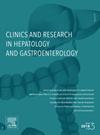重新考虑svr后的景观:尽管纤维化消退,但脂肪变性上升的临床意义。
IF 2.4
4区 医学
Q2 GASTROENTEROLOGY & HEPATOLOGY
Clinics and research in hepatology and gastroenterology
Pub Date : 2025-07-28
DOI:10.1016/j.clinre.2025.102661
引用次数: 0
摘要
Shengir等人最近的研究为通过直接作用抗病毒药物(DAAs)根除丙型肝炎病毒(HCV)后不断变化的代谢景观提供了令人信服的见解。虽然肝硬度和纤维化指标在svr后显著改善,但肝脂肪变性(HS)的患病率却矛盾地增加,突出了从病毒驱动的损伤到代谢功能障碍相关的脂肪变性肝病(MASLD)的转变。在这篇通信中,我们通过讨论svr后脂肪变性的临床和病理生理意义来扩展这些发现,强调即使在病毒学治愈的患者中也需要持续的代谢监测。我们还强调了仅基于BMI的传统风险分层的局限性,并呼吁采用改进的纵向方法来检测和管理svr后人群中的代谢性肝病。本文章由计算机程序翻译,如有差异,请以英文原文为准。
Reconsidering the post-SVR landscape: Clinical implications of rising steatosis despite fibrosis regression
The recent work by Shengir et al. offers compelling insight into the evolving metabolic landscape following hepatitis C virus (HCV) eradication via direct-acting antivirals (DAAs). While liver stiffness and fibrosis indices significantly improved post-SVR, hepatic steatosis (HS) paradoxically increased in prevalence, highlighting a shift from virus-driven injury to metabolic dysfunction-associated steatotic liver disease (MASLD). In this correspondence, we expand upon these findings by discussing the clinical and pathophysiological implications of post-SVR steatosis, underscoring the need for ongoing metabolic surveillance even in patients with virologic cure. We also emphasize the limitations of traditional risk stratification based on BMI alone and call for refined, longitudinal approaches to detect and manage metabolic liver disease in the post-SVR population.
求助全文
通过发布文献求助,成功后即可免费获取论文全文。
去求助
来源期刊

Clinics and research in hepatology and gastroenterology
GASTROENTEROLOGY & HEPATOLOGY-
CiteScore
4.30
自引率
3.70%
发文量
198
审稿时长
42 days
期刊介绍:
Clinics and Research in Hepatology and Gastroenterology publishes high-quality original research papers in the field of hepatology and gastroenterology. The editors put the accent on rapid communication of new research and clinical developments and so called "hot topic" issues. Following a clear Editorial line, besides original articles and case reports, each issue features editorials, commentaries and reviews. The journal encourages research and discussion between all those involved in the specialty on an international level. All articles are peer reviewed by international experts, the articles in press are online and indexed in the international databases (Current Contents, Pubmed, Scopus, Science Direct).
Clinics and Research in Hepatology and Gastroenterology is a subscription journal (with optional open access), which allows you to publish your research without any cost to you (unless you proactively chose the open access option). Your article will be available to all researchers around the globe whose institution has a subscription to the journal.
 求助内容:
求助内容: 应助结果提醒方式:
应助结果提醒方式:


